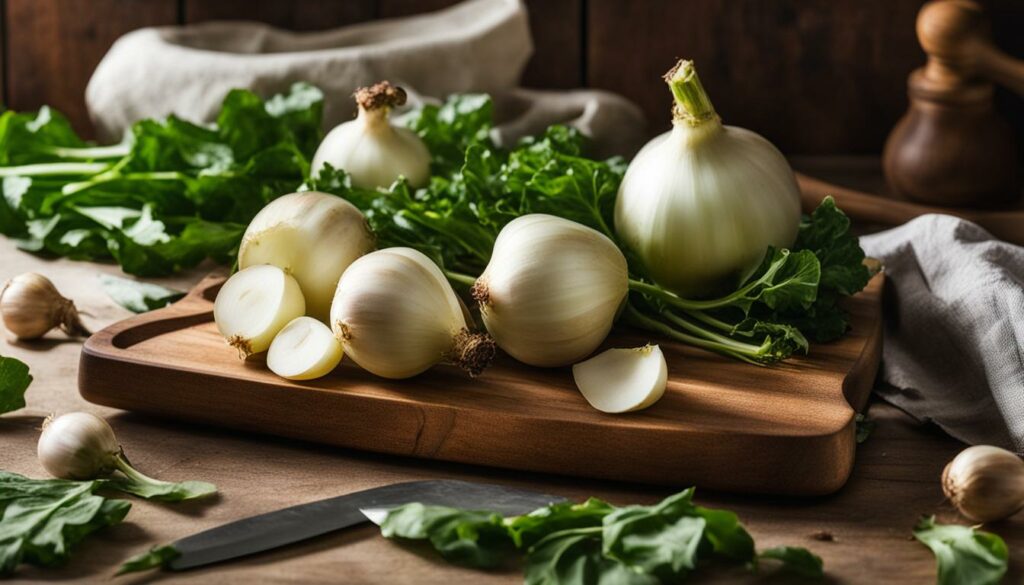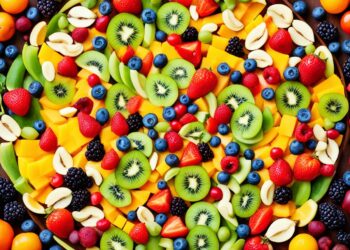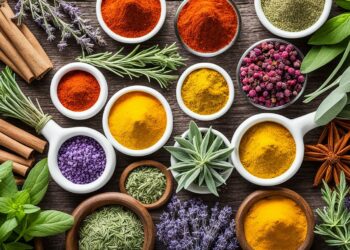Kohlrabi, a member of the cabbage family, is a versatile and nutritious vegetable that is widely consumed in Europe and Asia. This bulbous vegetable offers a myriad of health benefits and can be enjoyed in various delicious ways. Let’s explore the kohlrabi health benefits, its nutritional value, recipes, and uses.
Key Takeaways:
- Kohlrabi is a nutrient-dense vegetable rich in vitamin C, fiber, and potassium.
- It can be consumed raw or cooked and is commonly used in salads, slaws, and stir-fries.
- Kohlrabi is packed with antioxidants that help protect against chronic diseases.
- Its high fiber content supports a healthy gut microbiome and helps regulate blood sugar levels.
- Kohlrabi promotes heart health by reducing cholesterol levels and supports a strong immune system.
What is Kohlrabi?
Kohlrabi is a cruciferous vegetable that belongs to the cabbage family. It is closely related to cabbage, broccoli, and Brussels sprouts. The word “kohlrabi” is derived from the German words “kohl” meaning cabbage and “rübe” meaning turnip, reflecting its appearance.
Kohlrabi has a unique and distinct appearance. It features a round, bulbous shape that can range in color from purple, pale green, to white. The bulb sits above the ground and is surrounded by several sturdy, leafy stems branching out in different directions.
When it comes to taste, kohlrabi offers a combination of flavors. It has a mild, earthy taste with hints of sweetness. The texture is crisp and crunchy, reminiscent of broccoli stems. Some compare it to the taste of a cabbage, only milder and slightly sweeter.
Kohlrabi is a versatile vegetable that can be enjoyed in various ways. Its tender bulb and leaves are commonly used in salads, slaws, and stir-fries. It can also be cooked by boiling, sautéing, roasting, or grilling, giving it a softer texture and enhancing its natural flavors.
If you need a visual representation of kohlrabi, here is an image:
Nutritional Profile of Kohlrabi
Kohlrabi is a versatile vegetable that not only offers great taste but also packs a punch when it comes to nutrition. Here’s a closer look at the nutritional value of kohlrabi:
Kohlrabi Nutrients
Kohlrabi is low in calories but high in essential nutrients. A cup of raw kohlrabi provides approximately:
- 36 calories
- 8 grams of carbohydrates
- 5 grams of fiber
- 2 grams of protein
This makes kohlrabi a nutritious and filling food choice, as it is low in calories while providing a good amount of fiber. It can help you feel satisfied and maintain a healthy weight.
Kohlrabi Vitamins
Kohlrabi is particularly rich in vitamin C, which is an important antioxidant that boosts the immune system and helps protect against oxidative stress. One cup of kohlrabi provides an impressive 93% of the daily value of vitamin C. Additionally, kohlrabi contains a range of B vitamins, including vitamin B6, which is essential for brain development and function.
Kohlrabi Minerals
In addition to vitamins, kohlrabi is a good source of minerals. It contains significant amounts of potassium, which is essential for maintaining healthy blood pressure and heart function. Kohlrabi also provides magnesium, which supports bone health and helps regulate muscle and nerve function.
With its abundance of nutrients, including vitamins and minerals, kohlrabi is a great addition to a well-balanced diet.
Health Benefits of Kohlrabi
Kohlrabi offers several health benefits, making it a valuable addition to your diet. Its impressive nutritional profile is complemented by its ability to promote gut health, heart health, and a strong immune system.
Rich in Antioxidants for Protection
Kohlrabi is loaded with antioxidants, which play a crucial role in protecting your body against the harmful effects of free radicals. These antioxidants, such as vitamin C, anthocyanins, isothiocyanates, and glucosinolates, neutralize free radicals and help reduce the risk of chronic diseases, including heart disease and cancer.
Supports a Healthy Gut Microbiome
The fiber content in kohlrabi is essential for maintaining a healthy gut microbiome. Fiber acts as a prebiotic, providing nourishment for the beneficial bacteria in your gut. A healthy gut microbiome is associated with improved digestion, enhanced nutrient absorption, and a stronger immune system.
Promotes Heart Health
Kohlrabi can contribute to a healthy heart due to its cholesterol-lowering properties. It contains compounds that help lower LDL (bad) cholesterol levels, reducing the risk of cardiovascular diseases. Additionally, the potassium content in kohlrabi aids in maintaining healthy blood pressure levels, further supporting heart health.
Strengthens the Immune System
Consuming kohlrabi can boost your immune system, thanks to its rich array of nutrients. Vitamin C, found abundantly in kohlrabi, is known for its immune-boosting properties. It enhances the production of white blood cells, which are vital for fighting off infections and keeping your immune system strong.
“Kohlrabi is a nutritional powerhouse that can benefit gut health, heart health, and the immune system.”
With its powerful antioxidants, fiber-rich composition, heart-protective qualities, and immune-boosting properties, kohlrabi is a vegetable that truly supports your overall health and well-being.
| Health Benefits of Kohlrabi | Keywords |
|---|---|
| Rich in antioxidants | kohlrabi antioxidants |
| Supports gut health | kohlrabi gut health |
| Promotes heart health | kohlrabi heart health |
| Strengthens the immune system | kohlrabi immune system |
How to Store and Cook Kohlrabi
Proper storage and cooking techniques can help you make the most of your kohlrabi. Here are some tips on how to store and cook this versatile vegetable:
Storing Kohlrabi
Kohlrabi can be stored in a sealed bag or container in the fridge for up to a week. To maximize freshness, remove the stems and leaves before storing. The leaves can be used in recipes like salads or sautés, while the bulb is the main focus for cooking.
Cooking Kohlrabi
Kohlrabi can be cooked in various ways, depending on your preference:
- Boiling: Peel and slice the kohlrabi bulb into desired shapes or grate it. Boil the pieces in salted water until tender.
- Sautéing: Thinly slice kohlrabi and sauté it in olive oil or butter until it becomes tender and slightly caramelized.
- Roasting: Cut kohlrabi into small wedges or cubes and toss them with olive oil, salt, and pepper. Roast in the oven until they turn golden and crispy on the outside.
- Grilling: Slice kohlrabi into thin rounds and grill them over medium heat until they develop grill marks and become tender.
Kohlrabi can be enjoyed both raw and cooked. Its mild and slightly sweet flavor pairs well with various dishes. You can add raw kohlrabi to salads for a crunchy texture or cook it in soups, stir-fries, or gratins for a softer and more savory experience.
To help you visualize the storage and cooking process, here’s an image of fresh kohlrabi bulbs:

With these simple techniques, you can store kohlrabi to retain its freshness and cook it in different ways to create delicious and healthy meals.
How to Add Kohlrabi to Your Diet
Kohlrabi is a versatile vegetable that can be incorporated into your diet in various delicious ways. Whether you’re looking to enjoy it as a snack, add it to salads and slaws, or use it in cooked dishes, there are plenty of kohlrabi recipes to explore. Here are some creative ideas for incorporating kohlrabi into your meals:
1. Crunchy Snack
Chop kohlrabi into thin slices or sticks and enjoy it as a crunchy snack with your favorite dip, such as hummus or yogurt-based dressings. This makes for a refreshing and nutritious alternative to traditional snack options.
2. Salads and Slaws
Add grated or thinly sliced kohlrabi to your salads or slaws for a delightful crunch and mild, slightly sweet flavor. Kohlrabi pairs well with other vegetables like carrots, cabbage, and radishes, creating a refreshing and colorful addition to your meal.
3. Fritters
Experiment with kohlrabi fritters by grating the vegetable and mixing it with eggs, breadcrumbs, and seasonings. Pan-fry the mixture until golden brown for a tasty and satisfying appetizer or side dish.
4. Roasted, Sautéed, or Boiled
Kohlrabi can be roasted, sautéed, or boiled to bring out its natural sweetness and enhance its texture. When roasting or sautéing, cut the kohlrabi into wedges or cubes, toss with olive oil and seasonings, and cook until tender. Boiled kohlrabi can be added to soups and stews for an extra nutritious boost.
5. Leafy Additions
Don’t forget about the leaves of the kohlrabi plant! They can be added to salads, sautéed with garlic and olive oil, or used as a flavorful addition to other recipes. The leaves have a taste similar to collard greens and can be a valuable addition to your meals.
By exploring these versatile ways of using kohlrabi, you can enjoy its crisp texture, mild flavor, and reap the numerous health benefits it offers. Find inspiration in kohlrabi recipes and incorporate this nutritious vegetable into your meals for a tasty and wholesome dining experience.
| Recipe | Description | Preparation Time | Serving |
|---|---|---|---|
| Kohlrabi Slaw | A refreshing slaw made with shredded kohlrabi, carrots, and a tangy dressing. | 15 minutes | 4 servings |
| Roasted Kohlrabi and Chickpeas | A simple and flavorful dish combining roasted kohlrabi and crispy chickpeas. | 40 minutes | 2 servings |
| Kohlrabi Fritters | Crispy fritters made with grated kohlrabi, eggs, breadcrumbs, and herbs. | 30 minutes | 12 fritters |
| Kohlrabi and Potato Soup | A comforting soup featuring kohlrabi, potatoes, and aromatic herbs. | 1 hour | 6 servings |
Varieties and Growing Kohlrabi
Kohlrabi is a versatile vegetable that comes in different varieties, offering various colors and flavors to suit different preferences. The most common kohlrabi varieties are:
- Green Kohlrabi: This is the standard variety with a pale green bulb and green stems.
- Purple Kohlrabi: This variety has a beautiful purple bulb and purple stems.
- White Kohlrabi: With a creamy white bulb and green stems, this variety has a milder flavor.
- Blue Kohlrabi: This unique variety has a bluish hue and a slightly nutty taste.
Now that you know about the different kohlrabi varieties, let’s delve into how to grow this nutritious vegetable in your own garden.
Growing kohlrabi is relatively easy, making it a great addition to any home garden. Here are some simple steps to get started:
1. Choose the Right Time and Location
Kohlrabi thrives in cool weather, so it is best to sow the seeds a few weeks before the last frost in the spring. Select a sunny location in your garden with well-draining soil.
2. Prepare the Soil
Before sowing the seeds, prepare the soil by removing any weeds or debris. Loosen the soil and add some organic matter, such as compost or well-rotted manure, to improve its fertility.
3. Sow the Seeds
Sow the kohlrabi seeds directly into the prepared soil, spacing them about 4-6 inches apart. Plant the seeds at a depth of ¼ to ½ inch and cover them lightly with soil. Water the area gently to keep the soil moist.
4. Care and Maintenance
To ensure successful growth, keep the soil consistently moist but not waterlogged. Thin out the seedlings when they reach a height of 2-3 inches, leaving the strongest plants to grow. Remove any weeds that may compete with kohlrabi for nutrients.
5. Harvesting
Kohlrabi is ready to harvest in about 45 to 60 days, depending on the variety and growing conditions. The bulb should be firm and about the size of a tennis ball when ready. Gently pull the bulb from the ground or use a sharp knife to cut it just above the soil level.
Now that you have learned how to grow kohlrabi, you can enjoy the satisfaction of harvesting your own fresh and nutritious produce.
| Kohlrabi Variety | Color | Flavor |
|---|---|---|
| Green Kohlrabi | Pale green | Crisp and slightly sweet |
| Purple Kohlrabi | Purple | Mild, slightly peppery |
| White Kohlrabi | Creamy white | Mild and delicate |
| Blue Kohlrabi | Bluish hue | Nutty and mild |

With the knowledge of the different kohlrabi varieties and the steps to grow them, you can now enjoy the satisfaction of cultivating your own vibrant and flavorful kohlrabi in your garden.
Conclusion
Incorporating kohlrabi into your meals is a smart choice for boosting your health and nutrition. This versatile vegetable is packed with vitamins, minerals, fiber, and antioxidants, making it a nutrient powerhouse. By adding kohlrabi to your diet, you can enjoy the numerous health benefits it offers while embracing its unique taste and texture.
Whether you prefer to enjoy kohlrabi raw or cooked, there are endless possibilities for incorporating it into your meals. You can slice it into salads or slaws, sauté it as a side dish, roast it with your favorite spices, or even boil it for soups and stews. The leaves of kohlrabi are also edible and can be used in various recipes.
With its impressive nutritional profile and culinary versatility, kohlrabi is a fantastic addition to a healthy and balanced diet. Start exploring the world of kohlrabi recipes and discover new ways to incorporate this flavorful vegetable into your meals. Your taste buds and your body will thank you for it!
FAQ
What are the health benefits of kohlrabi?
Kohlrabi is a nutritious vegetable that offers several health benefits. It is rich in antioxidants, supports gut health, promotes heart health, and boosts the immune system.
What is kohlrabi and how does it taste?
Kohlrabi is a vegetable from the cabbage family with a round bulb and multiple stems. It has a taste and texture similar to broccoli stems and cabbage, but slightly sweeter.
What nutrients does kohlrabi contain?
Kohlrabi is packed with essential nutrients, including vitamin C, fiber, potassium, vitamin B6, and magnesium.
How should I store and cook kohlrabi?
Kohlrabi can be stored in the fridge for up to a week. The bulb should be peeled and can be boiled, sautéed, roasted, or grilled.
How can I incorporate kohlrabi into my diet?
Kohlrabi can be enjoyed raw in salads, chopped as a crunchy snack, or cooked in various dishes such as soups, stews, and fritters.
Are there different varieties of kohlrabi?
Yes, kohlrabi comes in different varieties including green, purple, white, and blue.
Can I grow kohlrabi myself?
Yes, kohlrabi is easy to grow. The seeds can be sown a few weeks before the last frost in spring, and it can be harvested in 45 to 60 days.




